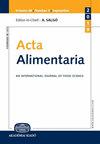Enterococci in the dairy and sausage industry: Is sanitation sufficient to remove biofilm?
IF 1
4区 农林科学
Q4 FOOD SCIENCE & TECHNOLOGY
引用次数: 0
Abstract
Enterococcus spp. were isolated from sausage and yogurt line production. The genomic assay was performed by PCR, and distinct enterococci (n = 28) were identified. Testing revealed that 10.7% of the isolates had a resistant phenotype, 7.1% were resistant to erythromycin (Enterococcus faecium) and 3.5% were resistant to tetracycline (Enterococcus gallinarum). Enterococci cells and biofilm formation in 24 well polystyrene plates and the effect of sanitisation procedures in these biofilms were determined. The sanitisers were chlorinated alkaline H (CAH), chlorinated alkaline A (CAA), quaternary ammonium D (QAD), quaternary ammonium M (QAM), chlorine dioxide (CD), sodium hypochlorite (SH), and peracetic acid (PA). A total of 7 isolates (25%) moderately and the others poorly formed biofilms. The best reduction results were 61 and 55% of the cells with the CAH sanitiser in BHI and water, respectively. The PAA, SH, and CD sanitisers showed low efficiency on Enterococcus planctonics, and the other had an effect on cell growth. The sanitisers CAH, QAD, QAM, PAA, and SH showed efficiency in reducing the cell viability of Enterococcus in biofilms, and values obtained from CAA and CD suggested low biofilm removal capacity. Enterococcus spp. form biofilms and have become a problem in the food industry.乳制品和香肠行业的肠球菌:卫生设施足以去除生物膜吗?
从香肠和酸奶生产线上分离出肠球菌。通过PCR进行基因组测定,并鉴定出不同的肠球菌(n=28)。测试显示,10.7%的分离株具有耐药性表型,7.1%对红霉素(粪肠球菌)具有耐药性,3.5%对四环素(鸡肠球菌)具有抗性。测定了24孔聚苯乙烯板中的肠球菌细胞和生物膜的形成,以及这些生物膜中消毒程序的效果。消毒剂为氯化碱H(CAH)、氯化碱A(CAA)、季铵D(QAD)、季铵盐M(QAM)、二氧化氯(CD)、次氯酸钠(SH)和过乙酸(PA)。共有7个分离株(25%)形成中等程度的生物膜,其他分离株形成较差的生物膜。在BHI和水中,CAH消毒剂的最佳还原结果分别为61%和55%的细胞。PAA、SH和CD消毒剂对平球菌的杀灭率较低,另一种对细胞生长有影响。消毒剂CAH、QAD、QAM、PAA和SH在降低肠球菌在生物膜中的细胞活力方面表现出有效性,从CAA和CD获得的值表明生物膜去除能力低。肠球菌形成生物膜,已成为食品工业中的一个问题。
本文章由计算机程序翻译,如有差异,请以英文原文为准。
求助全文
约1分钟内获得全文
求助全文
来源期刊

Acta Alimentaria
农林科学-食品科技
CiteScore
1.80
自引率
0.00%
发文量
47
审稿时长
18-36 weeks
期刊介绍:
Acta Alimentaria publishes original papers and reviews on food science (physics, physical chemistry, chemistry, analysis, biology, microbiology, enzymology, engineering, instrumentation, automation and economics of foods, food production and food technology, food quality, post-harvest treatments, food safety and nutrition).
 求助内容:
求助内容: 应助结果提醒方式:
应助结果提醒方式:


